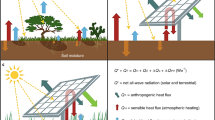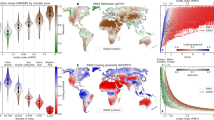Abstract
Deserts are prioritized as recipient environments for solar energy development; however, the impacts of this development on desert plant communities are unknown. Desert plants represent long-standing ecological, economic and cultural resources for humans, especially indigenous peoples, but their role in supplying ecosystem services (ESs) remains understudied. We measured the effect of solar energy development decisions on desert plants at one of the world’s largest concentrating solar power plants (Ivanpah, California; capacity of 392 MW). We documented the negative effects of solar energy development on the desert scrub plant community. Perennial plant cover and structure are lower in bladed treatments than mowed treatments, which are, in turn, lower than the perennial plant cover and structure recorded in undeveloped controls. We determined that cacti species and Mojave yucca (Yucca schidigera) are particularly vulnerable to solar development (that is, blading, mowing), whereas Schismus spp.—invasive annual grasses—are facilitated by blading. The desert scrub community confers 188 instances of ESs, including cultural services to 18 Native American ethnic groups. Cultural, provisioning and regulating ESs of desert plants are lower in bladed and mowed treatments than in undeveloped controls. Our study demonstrates the potential for solar energy development in deserts to reduce biodiversity and socioecological resources, as well as the role that ESs play in informing energy transitions that are sustainable and just.
This is a preview of subscription content, access via your institution
Access options
Access Nature and 54 other Nature Portfolio journals
Get Nature+, our best-value online-access subscription
$29.99 / 30 days
cancel any time
Subscribe to this journal
Receive 12 digital issues and online access to articles
$119.00 per year
only $9.92 per issue
Buy this article
- Purchase on Springer Link
- Instant access to full article PDF
Prices may be subject to local taxes which are calculated during checkout





Similar content being viewed by others
Data availability
An Excel workbook with all raw plant data is included as Source data.
References
Halmo, D. B., Stoffle, R. W. & Evans, M. J. Paitu Nanasuagaindu Pahonupi (Three Sacred Valleys): cultural significance of Gosiute, Paiute, and Ute plants. Hum. Organ. 52, 142–150 (1993).
Stoffle, R. W., Halmo, D. B. & Austin, D. E. Cultural landscapes and traditional cultural properties: a southern Paiute view of the Grand Canyon and Colorado River. Am. Indian Q. 21, 229–249 (1997).
Lee, R. B. in Man the Hunter (eds Lee, R. B. & DeVore, I.) 30–48 (Aldine, 1968).
Smith, M., Veth, P., Hiscock, P. & Wallis, L. A. in Desert Peoples, Archaeological Perspectives Vol. 1 (eds Veth, P. et al.) Ch. 1 (Blackwell, 2005).
Stoffle, R. W. & Evans, M. J. Holistic conservation and cultural triage: American Indian perspectives on cultural resources. Hum. Organ 49, 91–99 (1990).
Anderson, M. K. Tending the Wild: Native American Knowledge and the Management of California’s Natural Resources (UC Press, 2005).
Saenz-Hernandez, C., Corrales-Garcia, J. & Aquino-Perez, G. in Cacti: Biology and Uses (ed. Nobel, P. S.) 211–234 (UC Press, 2002).
Larsen, L. & Harlan, S. L. Desert dreamscapes: residential landscape preference and behavior. Landsc. Urban Plan. 78, 8–100 (2006).
Rokeach, M. The Nature of Human Values (Free Press, 1973).
Schwartz, S. H. & Bilksy, W. Toward a universal psychology structure of human values. J. Person. Soc. Psychol. 58, 878–891 (1987).
Kamakura, W. A. & Novak, T. P. Value system segmentation: exploring the meaning of LOV. J. Consum. Res. 19, 119–132 (1992).
Moore-O’Leary, K. A. et al. Sustainability of utility-scale solar energy—critical ecological concepts. Front. Ecol. Environ. 15, 385–394 (2017).
Hernandez, R. R. et al. Techno-ecological synergies of solar energy produce beneficial outcomes across industrial-ecological boundaries to mitigate global change. Nat. Sustain. 2, 560–568 (2019).
Carpenter, S. R. et al. Science for managing ecosystem services: beyond the Millennium Ecosystem Assessment. Proc. Natl Acad. Sci. USA 106, 1305–1312 (2009).
Folke, C. et al. Resilience and sustainable development: building adaptive capacity in a world of transformations. AMBIO 31, 437–440 (2002).
Daniel, T. C. et al. Contributions of cultural services to the ecosystem services agenda. Proc. Natl Acad. Sci. USA 109, 8812–8819 (2012).
Chan, K. M. A. et al. Where are cultural and social in ecosystem services? A framework for constructive engagement. BioScience 62, 744–756 (2012).
Farber, S. C., Constanza, R. & Wilson, M. A. Economic and ecological concepts for valuing ecosystem services. Ecol. Econ. 41, 375–392 (2002).
Copeland, S. M., Bradford, J. B., Duniway, M. C. & Schuster, R. M. Potential impacts of overlapping land-use and climate in a sensitive dryland: a case study of the Colorado Plateau, USA. Ecosphere 8, e01823 (2017).
Durant, S. M. et al. Forgotten biodiversity in desert ecosystems. Science 336, 1379–1380 (2012).
McDonald, R. I. et al. Energy sprawl or energy efficiency: climate policy impacts on natural habitat for the United States of America. PLoS ONE 4, e6802 (2009).
Hernandez, R. R. et al. Solar energy development impacts on terrestrial ecosystems. Proc. Natl Acad. Sci. USA 112, 13579–13584 (2015a).
Hernandez, R. R. et al. The land-use efficiency of big solar. Environ. Sci. Technol. 48, 1315–1323 (2014).
Lovich, J. E. & Bainbridge, D. Anthropogenic degradation of the southern California desert ecosystem and prospects for natural recovery and restoration. Environ. Manag. 24, 309–326 (1999).
Hoffacker, M. K., Allen, M. F. & Hernandez, R. R. Land sparing opportunities for solar energy development in agricultural landscapes: a case study of the Great Central Valley, CA, USA. Environ. Sci. Technol. 51, 14472–14482 (2017).
Potter, C. Landsat time series analysis of vegetation changes in solar energy development areas of the Lower Colorado Desert, southern California. J. Geosci. Environ. Prot. 4, 1–6 (2016).
Li, Y. et al. Climate model shows large-scale wind and solar farms in the Sahara increase rain and vegetation. Science 361, 1019–1022 (2018).
Myers, N., Mittermeier, R. A., Mittermeier, C. G., da Fonseca, G. A. B. & Kent, J. Biodiversity hotspots for conservation priorities. Nature 403, 853–858 (2000).
Bidak, L. M., Kamal, S. A., Halmy, M. W. A. & Heneidy, S. Z. Goods and services provided by native plants in desert ecosystems: examples from the northwestern coastal desert of Egypt. Glob. Ecol. Conserv. 3, 433–447 (2015).
Liu, J. et al. Complexity of coupled human and natural systems. Science 317, 1513–1516 (2007).
Walsh, J. R., Carpenter, S. R. & Vander Zanden, M. J. Invasive species triggers massive loss of ecosystem services through a trophic cascade. Proc. Natl Acad. Sci. USA 113, 4081–4085 (2016).
Brooks, M. L. & Matchett, J. R. Spatial and temporal patterns of wildfires in the Mojave Desert, 1980-2004. J. Arid Environ. 67, 148–164 (2006).
Goettsch, B. et al. High proportion of cactus species threatened with extinction. Nat. Plants 1, 15142 (2015).
Drennan, P. M. & Nobel, P. S. Responses of CAM species to increasing atmospheric CO2 concentrations. Plant Cell Environ. 23, 767–781 (2000).
Díaz, S. et al. Incorporating plant functional diversity effects in ecosystem service assessments. Proc. Natl Acad. Sci. USA 104, 20684–20689 (2007).
Daily, G. C. & Matson, P. A. Ecosystem services: from theory to implementation. Proc. Natl Acad. Sci. USA 105, 9455–9456 (2008).
Kuletz, V. L. The Tainted Desert: Environmental and Social Ruin in the American West (Routledge, 1998).
Adamson, J. American Indian Literature, Environmental Justice, and Ecocriticism (Univ. Arizona Press, 2001).
Romero, H., Mendez, M. & Smith, P. Mining development and environmental injustice in the Atacama Desert of northern Chile. Environ. Justice 5, 70–76 (2012).
Vine, D. Base Nation: How U.S. Military Bases Abroad Harm America and the World (Henry Holt and Co., 2015).
Tsosie, R. Indigenous people and environmental justice: the impact of climate change. Univ. Col. Law Rev. 78, 1625–1678 (2007).
Mulvaney, D. Identifying the roots of Green Civil War over utility-scale solar energy projects on public lands across the American Southwest. J. Land Use Sci. 12, 493–515 (2017).
Brookshire, D. & Kaza, N. Planning for seven generations: energy planning of American Indian tribes. Energy Policy 62, 1506–1514 (2013).
Bronin, S. C. The promise and perils of renewable energy on tribal lands. Tulane Environ. Law J. 26, 221–237 (2013).
Polis, G. A. The Ecology of Desert Communities (Univ. Arizona Press, 1991).
Aranda-Rickert, A., Diez, P. & Marazzi, B. Extrafloral nectar fuels ant life in deserts. AoB PLANTS 6, plu068 (2014).
Rickleffs, R. E. & Hainsworth, F. R. Tenperature regulation in nestling cactus wren: the nest environment. Condor 71, 32–37 (1969).
Pfeiler, E. & Markow, T. A. Phylogeography of the cactophilic Drosophila and other arthropods associated with cactus necroses in the Sonoran Desert. Insects 2, 218–231 (2011).
Pellmyr, O., Thompson, J. N., Brown, J. M. & Harrison, R. G. Evolution of pollination and mutualism in the yucca moth lineage. Am. Nat. 148, 827–847 (1996).
Abella, S. R. & Berry, K. H. Enhancing and restoring habitat for the desert tortoise. J. Fish. Wildl. Manag. 7, 255–279 (2016).
Hernandez, R. R. et al. Efficient use of land to meet sustainable energy needs. Nat. Clim. Change 5, 353–358 (2015).
Clark, W. C., van Kerkhoff, L., Lebel, L. & Gallopin, G. C. Crafting usable knowledge for sustainable development. Proc. Natl Acad. Sci. USA 113, 4570–4578 (2016).
Acknowledgements
We thank B. Beatty, B. Elkin, C. François, T. Heitz, M. King, J. Meyers, M. Milliron, G. Piantka, L. Rose, A. Scheib, T. Sisk, D. Stoms, J. Valentine, J. Weigand and B. Weise for feedback that improved this study. We thank NRG Energy for their cooperation on and support of this project. We thank J. Whitney for assistance with field data collection and K. Lamy for graphic design assistance. We received funding for this research from the California Energy Commission (Electric Program Investment Charge-15-060), the Bureau of Land Management California (grant number L19AC00279) and UC Davis Agricultural Experiment Station Hatch Projects (grant numbers CA-R-A-6689 and CA-D-LAW-2352-H).
Author information
Authors and Affiliations
Contributions
S.M.G. and R.R.H. conceptualized the study, designed the experiment and collected field data. S.M.G. conducted literature syntheses and analysed the data. S.M.G. and R.R.H. wrote the manuscript.
Corresponding author
Ethics declarations
Competing interests
The authors declare no competing interests.
Additional information
Publisher’s note Springer Nature remains neutral with regard to jurisdictional claims in published maps and institutional affiliations.
Supplementary information
Supplementary Information
Supplementary Tables 1–5, methods and text.
Source data
Source Data Fig. 1
Excel workbook of raw data used in study.
Rights and permissions
About this article
Cite this article
Grodsky, S.M., Hernandez, R.R. Reduced ecosystem services of desert plants from ground-mounted solar energy development. Nat Sustain 3, 1036–1043 (2020). https://doi.org/10.1038/s41893-020-0574-x
Received:
Accepted:
Published:
Issue Date:
DOI: https://doi.org/10.1038/s41893-020-0574-x
This article is cited by
-
Aligning renewable energy expansion with climate-driven range shifts
Nature Climate Change (2024)
-
Booming solar energy is encroaching on cropland
Nature Geoscience (2023)
-
Floating solar power could help fight climate change — let’s get it right
Nature (2022)
-
Partial shading by solar panels delays bloom, increases floral abundance during the late-season for pollinators in a dryland, agrivoltaic ecosystem
Scientific Reports (2021)
-
Energy and water co-benefits from covering canals with solar panels
Nature Sustainability (2021)



